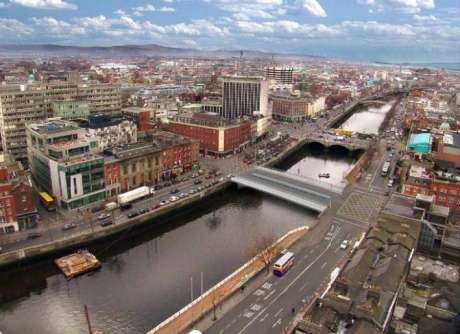Marlborough Street bridge plan looks increasingly absurd amid decimated city centre traffic levels
 dublin |
environment |
opinion/analysis
dublin |
environment |
opinion/analysis  Tuesday January 24, 2012 11:32
Tuesday January 24, 2012 11:32 by Vincent Byrne
by Vincent Byrne
Dublin is still reeling from its boom period and the cacophony of high-flown plans it threw up. Now that it's all over, how do the various projects stand up?

Overhead view of Dublin City Council’s planned “public transport priority” bridge at Marlborough Street – Hawkins Street.
Dublin is still reeling from its boom period and the cacophony of high-flown plans it threw up. Now that it's all over, how do the various projects stand up?
One boom-era plan that seems set to proceed is Dublin City Council's building of a “public transport priority” bridge over the Liffey between Marlborough Street and Hawkins Street.
Conceived as a relief bridge while Metro North was under construction at adjacent O’Connell Bridge, it would later accommodate a southbound line of the city-centre Luas link, plus buses and taxis.
Metro North is more or less cancelled, and the Luas link, while pencilled in to proceed in 2015, has yet to secure funding of an estimated €170 million.
The location of the new bridge so close to O’Connell Bridge was always problematic, but it was accepted by city stakeholders in the context of plansat the time, and passed through the planning system with little or no objection.
But now, with the dramatic decline in city-centre traffic levels over the past three or four years, and changes to other plans, the Marlborough Street – Hawkins Street bridge is becoming an increasingly absurd idea.
It will effectively provide a broad new multi-lane road bridge a few metres to the east of the widest bridge in the country and one of the widest of its kind in the world.
The bridge has no real circulation gain, as it simply leaves and enters the same traffic circulation system that already exists in the area, serving only to bypass O’Connell Bridge.
Nor is the bridge needed by Luas - the wide streets handed down to us by the Georgian planners of the 18th century give ample space along O'Connell Street and Westmoreland Street for a Luas line travelling in eachdirection, plus vehicle, cycle lane and footpath space.
When and if the Luas link eventually comes to be constructed, the obvious route to take (and despite the results of ‘route selection’ processes) is that of the original alignment with both directions running along O’Connell Street, O’Connell Bridge and Westmoreland Street, not least for the reduced costs of keeping the two lines together.
The city centre streets and bridges are the product of the great period of classical urban planning in the 18th century. Bridges on the Liffey were built at a consistent distance from each other, and the river and streets led to views of carefully positioned setpiece buildings.
The regular spacing of bridges along the Liffey was observed for hundreds of years, until 2003 when James Joyce Bridge was built in-between two older bridges near Queen Street. The disorienting, incoherent effect of bridges built close to one another here is plain for all to see.
James Joyce Bridge makes no sense in its location, although it was in fact a legacy of Dublin Corporation's insane 1960s road plans for central Dublin and should arguably have been shelved when the body of those plans were shelved in the 1980s.
Likewise, combined factors today including the recession, the opening of the Samuel Beckett relief bridge in the docklands and the huge increase in the popularity of cycling arising from the Cycle to Work and bike rental schemes have radically changed traffic conditions in the centre over past the past couple of years, and future plans provide for further reduction of traffic.
The justification for the Marlborough Street – Hawkins Street bridge is now extremely shaky and we should face up to it. It is a product of the distorted, addled period that was the economic boom in Dublin, and its unprecedented pressures.
The minor circulation gain in linking Marlborough Street and Hawkins Street will be massively outweighed by its impact on the plan of one of Europe’s great classical cities.
Proceeding with the bridge now will repeat the town-planning mistake of James Joyce Bridge on a grand scale and will leave another stain on the record of Dublin City Council.
It is not too late to reconsider. The site has been hoarded off since the New Year but no construction work has begun. A review of the bridge should now be undertaken by the government.
Comments (1 of 1)
Jump To Comment: 1Good story. That bridge looks cat, ye think it fell out of the sky, all most as daft a plan that unfolded a few years ago to run a GIANT cable car system above the Liffey.
Once again traffic is given priority, they'll never learn.
Have ye heard any more about the plans to level Moore Street ?
Indymedia Ireland is a media collective. We are independent volunteer citizen journalists producing and distributing the authentic voices of the people. Indymedia Ireland is an open news project where anyone can post their own news, comment, videos or photos about Ireland or related matters.